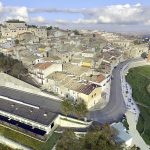Castelluccio Valmaggiore
With Faeto and Celle di San Vito, Castelluccio completes the settlement system developed along the Celone valley. The agglomeration, in fact, gathered around the massive circular tower, strategically dominates the entire valley from which it takes its name.
The origins of the town date back to the early eleventh century, at the time of the Byzantine domination of Daunia. The site, built in an area of archaeological finds, provided a strategic observation point on the Traiana road and a very important garrison guarding the nascent Troia. The urban structure, originally equipped with walls and two large gates, Pozzo and Piscero, was centered on the circular tower that still dominates the town. The mighty construction was part of a larger plan of territorial reorganization operated along the subapennine cordon by the catapano Basilio Boiannes, representative of the authority of the Eastern Empire in Puglia, in the defensive function of the border with the Longobard Duchy of Benevento.
The defensive character of the tower is evidenced by the compact shape engraved by small openings and by the elevated position of the entrance reachable with a removable wooden ladder in case of attack. Near the tower stands the parish church dedicated to St. John the Baptist, built in the middle of the last century, which preserves interesting evidence of the Baroque era. The church of Santa Maria delle Grazie, dating back to the 16th-17th centuries, is rich in precious furnishings.
PLACES TO GOIn town
The circular tower, the parish church dedicated to St. John the Baptist, the church of Santa Maria delle Grazie, Paolella Palace (a noble palace of the 18th century), the Visitor Center on the ecology of the river.Nearby
The Petrera woods with its characteristic “cold bridge”, in stone with a round arch, the Celone creek with its water mills, the heights that culminate with Mount Cornacchia, the highest peak in Puglia, included in the pSIC “Mount Cornacchia-Faeto woods”.EVENTS CALENDAR
- Last carnival sunday Carnival Wedding, Mardi Gras Carnival Death with a masked parade.
- On March 19, the bonfire of Saint Joseph.
- Way of the Cross on Good Friday.
- Last saturday of April festival of the Madonna Incoronata with a parade of floats.
- St. John the Baptist’s day festival on June 24th.
- Pizza’s country festival on the 10th and orecchiette’s country festival on the second Saturday of August.
- Festival of Saint Rocco on August 16th with a procession.
- Pettole’s country festival on December 26th.
Roberta De IulioIN THE KITCHEN
Many preparations in common with Castelluccio dei Sauri. Dried beans and laganelle, spezzatielle (stew, actually “soup”) of lamb, asparagus and peas, sémmele (semolina, sausage and cheese), loffe de moneche (fried dough and sprinkled with sugar).

![castelluccio_gallerypaesi_img1[1]](https://www.museovalledelcelone.it/wp-content/uploads/2022/03/castelluccio_gallerypaesi_img11-150x150.jpg)
![castelluccio_gallerypaesi_img2[1]](https://www.museovalledelcelone.it/wp-content/uploads/2022/03/castelluccio_gallerypaesi_img21-150x150.jpg)
![castelluccio_gallerypaesi_img3[1]](https://www.museovalledelcelone.it/wp-content/uploads/2022/03/castelluccio_gallerypaesi_img31-150x150.jpg)


![castelluccio_gallerypaesi_img6[1]](https://www.museovalledelcelone.it/wp-content/uploads/2022/03/castelluccio_gallerypaesi_img61-150x150.jpg)
![castelluccio_gallerypaesi_img7[1]](https://www.museovalledelcelone.it/wp-content/uploads/2022/03/castelluccio_gallerypaesi_img71-150x150.jpg)
![castelluccio_gallerypaesi_img7bis[1]](https://www.museovalledelcelone.it/wp-content/uploads/2022/03/castelluccio_gallerypaesi_img7bis1-150x150.jpg)
![castelluccio_gallerypaesi_img8[1]](https://www.museovalledelcelone.it/wp-content/uploads/2022/03/castelluccio_gallerypaesi_img81-150x150.jpg)
![castelluccio_gallerypaesi_img9[1]](https://www.museovalledelcelone.it/wp-content/uploads/2022/03/castelluccio_gallerypaesi_img91-150x150.jpg)
![castelluccio_gallerypaesi_img10[1]](https://www.museovalledelcelone.it/wp-content/uploads/2022/03/castelluccio_gallerypaesi_img101-150x150.jpg)
![castelluccio_gallerypaesi_img11[1]](https://www.museovalledelcelone.it/wp-content/uploads/2022/03/castelluccio_gallerypaesi_img111-150x150.jpg)
![castelluccio_gallerypaesi_img12[1]](https://www.museovalledelcelone.it/wp-content/uploads/2022/03/castelluccio_gallerypaesi_img121-150x150.jpg)
![castelluccio_gallerypaesi_img13[1]](https://www.museovalledelcelone.it/wp-content/uploads/2022/03/castelluccio_gallerypaesi_img131-150x150.jpg)
![castelluccio_gallerypaesi_img14[1]](https://www.museovalledelcelone.it/wp-content/uploads/2022/03/castelluccio_gallerypaesi_img141-150x150.jpg)
![castelluccio_gallerypaesi_img15[1]](https://www.museovalledelcelone.it/wp-content/uploads/2022/03/castelluccio_gallerypaesi_img151-150x150.jpg)
![castelluccio_gallerypaesi_img16[1]](https://www.museovalledelcelone.it/wp-content/uploads/2022/03/castelluccio_gallerypaesi_img161-150x150.jpg)
![castelluccio_gallerypaesi_img17[1]](https://www.museovalledelcelone.it/wp-content/uploads/2022/03/castelluccio_gallerypaesi_img171-150x150.jpg)
![castelluccio_gallerypaesi_img18[1]](https://www.museovalledelcelone.it/wp-content/uploads/2022/03/castelluccio_gallerypaesi_img181-150x150.jpg)
![castelluccio_gallerypaesi_img19[1]](https://www.museovalledelcelone.it/wp-content/uploads/2022/03/castelluccio_gallerypaesi_img191-150x150.jpg)
![castelluccio_gallerypaesi_img20[1]](https://www.museovalledelcelone.it/wp-content/uploads/2022/03/castelluccio_gallerypaesi_img201-150x150.jpg)
![castelluccio_gallerypaesi_img27[1]](https://www.museovalledelcelone.it/wp-content/uploads/2022/03/castelluccio_gallerypaesi_img271-150x150.jpg)
![castelluccio_gallerypaesi_img28[1]](https://www.museovalledelcelone.it/wp-content/uploads/2022/03/castelluccio_gallerypaesi_img281-150x150.jpg)
![castelluccio_gallerypaesi_img29[1]](https://www.museovalledelcelone.it/wp-content/uploads/2022/03/castelluccio_gallerypaesi_img291-150x150.jpg)
![castelluccio_gallerypaesi_img30[1]](https://www.museovalledelcelone.it/wp-content/uploads/2022/03/castelluccio_gallerypaesi_img301-150x150.jpg)
![castelluccio_gallerypaesi_img31[1]](https://www.museovalledelcelone.it/wp-content/uploads/2022/03/castelluccio_gallerypaesi_img311-150x150.jpg)
![castelluccio_gallerypaesi_img21[1]](https://www.museovalledelcelone.it/wp-content/uploads/2022/03/castelluccio_gallerypaesi_img211-150x150.jpg)
![castelluccio_gallerypaesi_img22[1]](https://www.museovalledelcelone.it/wp-content/uploads/2022/03/castelluccio_gallerypaesi_img221-150x150.jpg)
![castelluccio_gallerypaesi_img23[1]](https://www.museovalledelcelone.it/wp-content/uploads/2022/03/castelluccio_gallerypaesi_img231-150x150.jpg)
![castelluccio_gallerypaesi_img24[1]](https://www.museovalledelcelone.it/wp-content/uploads/2022/03/castelluccio_gallerypaesi_img241-150x150.jpg)
![castelluccio_gallerypaesi_img25[1]](https://www.museovalledelcelone.it/wp-content/uploads/2022/03/castelluccio_gallerypaesi_img251-150x150.jpg)
![castelluccio_gallerypaesi_img26[1]](https://www.museovalledelcelone.it/wp-content/uploads/2022/03/castelluccio_gallerypaesi_img261-150x150.jpg)